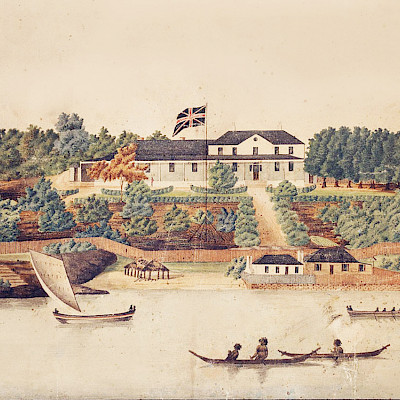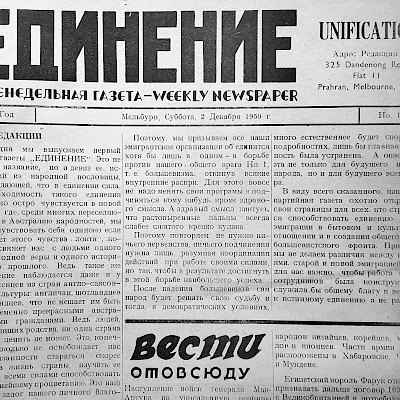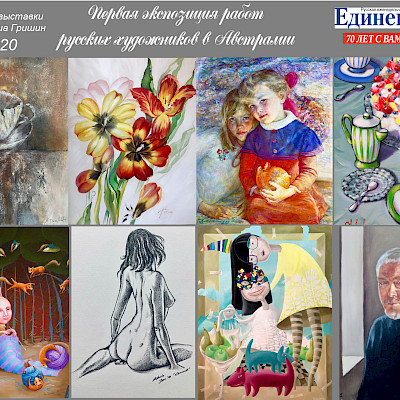In the 1930s, more than 30 Russian policemen served in the colonial law enforcement agency. After the Second World War, many of them moved to Australia (highlighted in bold text). Several of them settled in New South Wales and some chose to live in Queensland.
Keith Clark and I have already introduced the readers of "Unification" to some representatives of the Anti-Piracy Department: Vitaly Veriga and Constantin Kriloff, as well as their relative and friend, police reservist Arseney Savitsky (see "Brisbane Khabarov-2" and "Savitsky Camp Album"). But we now want to talk about the other Russian law enforcement officers in more detail.
Hong Kong (in the local dialect – Hong Gong, or Xianggang, "Fragrant Harbor"), got its name because of the huge market that sold oriental spices, exotic incense and medicinal herbs. By the middle of the 19th century it had become a British colony and a major centre of international trade. However, with the development of shipping, piracy also began to flourish. In 1914, the authorities formed military anti-piracy squads to protect British merchant ships, but 16 years later the army was forced to abandon this function.
Responsibility for escorting the ships was then assigned to the Hong Kong Police. Since its establishment, various ethnic divisions had served in the force. Group A consisted of British and European policemen, under the letter B were Indians, parts C and D were formed from residents of various provinces of China. In 1930, the E contingent was created and consisted of Russians.
Representatives of the White Wave of emigration moved to Hong Kong, mainly from Shanghai. These young, strong and imposing guys (recruits needed to be taller than 175 cm) were gladly accepted into the police force. They served in various units, including the Anti-Piracy Squad, created under the Hong Kong Marine Police Department. According to a report from 1930, there were 29 Russians in the first set of recruits.
On July 10, 1930, 14 men of the E Contingent went on their first anti-piracy mission to escort the “Empress of Canada”, an ocean liner built in 1920 in Scotland and owned by Canada Pacific. At that time, the ship cruised between the Metropolis and Japan, Hong Kong and China. Later, during World War II, the ship became an army transport, and in 1943 it was torpedoed by the Japanese and sunk.
Before going to sea, a group photo was taken of the anti-piracy guards, led by British Sergeant Arthur Ernest Charman, who had served in the Hong Kong police since 1924. In the mid-30s, the commander retired due to disability, and shortly before the start of World War II, he left for England with his wife and son. He died in 1969 and was buried in Hampshire, England.
The Russian recruits also left their autographs on the picture, thanks to which it was possible to establish their identity: I. Svoolin (E2), O. Biakoff (E3), L. Michaeelow (E4), C.A. Kriloff (E6), C.P. Sherevera (E11), D.V. Mikailovsky (E12), V. Pleshanoff (E16), A. Rostrovtseff (E17), V. Djigimont (E18), B.I. Ivanchenko (E21), V.L. Veriga (E22), S.P. Donetz (E23) and G.C. Rousakoff (E28). The remaining signature was unfortunately illegible.
Other members of the anti-piracy squad included V. Ivanov (E14), G. Shevkoplyas /Robinson (E24), F. Zadorin (E25), A. Ustiantseff (E29), A. Korshoonoff / Kai (E31) and A. Zaremba (E34). Others with unknown police badges numbers include A. Efremoff, V. Stepanoff, A. Pyatnitsky / Price, P. Sherevera and B. Levkovich / R. Leslie – perhaps they were assigned to other units of the Hong Kong police.
A Hong Kong police reserve division was also created, which included the manager of the Orient tobacco factory store G. Tavasterna and the broker B. Agafuroff; the clerk of an engineering and construction company L. Budagian and a horse trainer M. Krasnoperoff; the artist A. Savitsky and the former officer of the Russian Imperial Navy M. Affanasieff, who worked in Hong Kong as a captain on ships cruising in local coastal waters.
Mikhail Mitrofanovich Affanasieff was a graduate of the Russian Naval Corps and in 1905 he served as a senior lieutenant on the auxiliary cruiser "Eagle" of the Siberian Flotilla. He was also a participant in the First World War and from 1917 to 1919 he was assigned to a training trip abroad with a detachment of midshipmen. During the Civil War he was sent to the Special Manchu detachment and was promoted to captain of the 2nd rank. Mikhail eventually came to Hong Kong in the 1930s, arriving from France. Non-commissioned officer, Fedor Zadorin, also fought in the Civil War. In Shanghai, he was a member of the infantry section of the Union who had served in the Russian army and navy.
Researchers believe that up to 35 Russians served in the E contingent before the war. Perhaps there were even more of them, due to police officer retirements and losses in both peace time and war. In 1932, D. Mikhailovsky was buried at the Central City Cemetery in Hong Kong (the former Colonial Cemetery), 4 years later Sergeant V. Shishkin died, a native of Vyatka, and 2 year later, G. Onatsevich.
Sergeant V. Ilyin, who served in the British Army Assistance Group (BAAG), died in 1944 near Kunming in China – the military transport plane on which he was flying crashed. After the war, his remains were reburied at the War Cemetery in Hong Kong. In 1947, junior inspector A. Zaremba died as the result of an accident during a patrol. In 1950, at the age of 68 and a veteran of the reserve, M. Affanasieff, also passed away.
During Black Christmas in 1942, when the Japanese captured Hong Kong, several Russian police officers were interned as prisoners of war: L. Borisoff / Sterling, G. Danbrovsky with his wife and two-year-old child, D. Glazunoff, N. Elberg, L. Karpovich, I. Nemeroff and reservist A. Savitsky, as well as 7 representatives of the Anti-Piracy Department: V. Ivanoff, V. Veriga, G. Shevkoplyas / Robinson, F. Zadorin, G. Rusakoff, A. Korshoonoff / Kai and A. Zaremba – in total only 14 people.
Some of the members of the E contingent were on missions outside Hong Kong at that time. A. Ustiantseff was unlucky to be escorting a ship to Singapore, and on February 15, 1942, the island was captured by the Japanese and the policeman ended up in the infamous Changi prison camp and later moved to Sime Road camp. Chief investigator of one of departments of the Singapore Treasury, William Hacksworth, who was also captured and interned, drew Ustiantseff’s portrait and showed him as a very thin and emaciated prisoner. C.P. Sherevera was also among the prisoners of this prison camp.
Before the invasion, the families of A. Savitsky and K. Kriloff managed to evacuate to Australia. Kriloff joined the army in Brisbane and then served in the British Army Assistance Group (BAAG). It also included B. Levkovich / R. Leslie, who was transferred shortly before the occupation to the Food Control Department and managed to escape from captivity. During the war he worked in special units in India, where he married a nurse, Lavinia Charlotte Goodman.
The family of F. Zadorin was most likely among the British subjects evacuated from the colony. His wife's entry documents could not be found, but the papers of his son, Vladimir, indicate that he arrived in Brisbane in 1940 on the steamship ‘New Zealand’. At that time, the boy was only 10 years old, so he could hardly have come to Australia on his own.
Boris Ivanchenko and his wife were also among the evacuees from Hong Kong – in 1941 they settled in Sydney. Six years later, the former policeman won the lottery, and then became the owner of a milk bar on William Street - in the 50s, these establishments were very popular with Australians. Julia died in 1959 and was buried in Macquarie Park. Their daughter Alexandra Kolesnik rests with her. Boris passed away in 1974, at 64 years old. He is buried in the Russian section of Rockwood Cemetery.
In early December 1945, the former hospital ship Gerusalemme moored in the port of Fremantle (Western Australia), carrying several former Stanley prisoners: Georgy Fedorovich Shevkoplyas / George Robinson, Arkady Alekseevich Korshoonoff / Archibald Alex Kai, Andrey Leontievich Ustiantseff and Ivan Nikolayevich Nemeroff with his wife. All of them, except Shevkoplyas / Robinson, also settled in New South Wales.
Regretfully, there is very little information about the following trio: Sergeant Arkady Korshoonoff / Kai died in 1962 at the age of 54 and was buried in the cemetery in Metraville in Sydney's eastern district and his wife, Thelma Maria (1912-2012), rests with him. Ivan Nemeroff died in 1974 – he was 76 years old and was buried in the Russian section of the Rookwood cemetery. There is no information about Audrey Ustiantseff at all. Perhaps he changed his surname or emigrated somewhere else, like some of his other compatriots.
Later, another former Hong Kong policeman arrived in Sydney, who was also in Stanley camp during the war – Sergeant Lev Anatolyevich Borisoff / Leo Anatoly Sterling. In 1953, he married Nadezhda Serafina (nee Basargin), whom he met while still in the camp. The couple lived in Sydney's MacArthur district, where Lev worked as a shop assistant. He died in 1985 at the age of 69 and was cremated in Palmdale and Nadia died three years later. Hence, in all, there were 4 former Hong Kong police officers living in New South Wales.
Arseney Savitsky arrived in Queensland before the others who were liberated from the camp in 1945 – the family were waiting for him in Brisbane throughout the war. Junior Inspector Georgy Shevkoplyas / Robinson also arrived in 1945. He lived with his wife and daughters in Graysville. On May 3, 1954, at the age of 38, Tatyana Vasilievna died suddenly. She is buried in South Brisbane Cemetery. With a difference of only a few days, his former colleague, Inspector Konstantin Kriloff, also died. George outlived his wife by 20 years. His grave could not be found.
Lieutenant Boris Vasilievich Levkovich / Robert Basil Leslie moved to Australia with his mother in 1948. A doctor by education, she worked as a nurse in one of the local hospitals during the occupation. The head of the family died in 1944, their house was destroyed, and the Levkovich family did not wish to remain in Hong Kong. They lived in Sydney until 1951 and then settled in Queensland. Ekaterina Stanislavovna died in 1982, and Boris passed away a year later. Both of them are buried in the Russian section of the cemetery at Mount Gravatt.
Inspector Fedor Longinovich Zadorin arrived in Brisbane on the steamship Shansi in 1949. By this time, Mao Zedong (Chairman Mao) had already come to power in China, and Hong Kong was flooded with thousands of refugees from the mainland provinces of communist China who feared the persecution of the new authorities. The Zadorin family settled at 13 Walton Street in Dutton Park. The policeman passed away in 1983, at the age of 82 years old. Elena Konstantinovna died two years later. The couple rest in the Russian section of the cemetery at Mount Gravatt.
It is not known when Peter Petrovich Sherevera, a sergeant, came to Australia. In 1933 he saved a child from a sinking ship and was awarded a medal for bravery. At first he lived in Sydney, and in 1951 he married Natalia Lee (nee Saharoff). Having moved to Queensland, they became frequent guests in the house of an old friend – Vitaly Veriga. The Shereveras lived at 3 Martha Street in Camp Hill, and Peter worked as a carpenter in Virginia. His brother, Konstantin and family also lived in Brisbane from 1953, but then emigrated to the United States. Peter died in 1990 and Natalya Mikhailovna 7 years later. The graves could not be found, and most likely they were cremated.
In early September 1945, along with other prisoners from the Stanley camp, Georgy Kirillovich Rusakoff was also released. He arrived in Australia in 1954. His mother also lived in Brisbane – Paraskeva Ivanovna (died in 1962 at the age of 82), and his older sister – Natalia (married name Leschoff, 1904-1967). Georgy was an active member of the Russian community and was involved in the creation of the Russian Community Centre of Queensland. He died at the age of 70 in 1977 and his wife, Alexandra Fedorovna, passed away in 1984. They are all buried in Balmoral Cemetery in Morningside.
Victoria Smolin (Russia) and Keith Clark (UK)
Photos are taken from open sources on the Internet, newspapers "Daily Mail" (England), "Daily News", "Courier Mail", "Telegraph" (Australia), archives of Australia and Singapore; No. 06b, 07b, 8a - V. Smolin; 4a and 9b are from the family archives of N. Pio-Ulskaya and K. Clark. Special thanks to the Old Hong Kong website, its owners and volunteers for their invaluable work in preserving the historical memory of a bygone era.
Photo captions:
01abc – Fragrant Harbor – a major international trading port
02ab – The first E contingent before going on an anti-piracy mission
03abcd – Reservists M. Affanasieff, V. Rodionoff, L. Budagian and G. Tavasterna
04ab – Hong Kong Central Cemetery (formerly Colonial). Funeral of V. Shishkin
05abc – A. Korshoonoff / Kai and A. Ustiantseff were on board the hospital ship ‘Gerusalemme’.
06abc – Boris Levkovich moved to Australia in 1948 with his mother
07abc – Vladimir Fedorovich Zadorin (1930-2014) lived in New South Wales
08ab – Georgy Shevkoplyas / Robinson, presumably buried with his wife
09abc – H. Savitsky, L. Sherevera, A. Verigo, A. Savitsky, A. Havelaar, L. Kriloff, L. Veriga and V. Veriga
10ab – Grave of G. Rusakoff and his wife at Balmoral Cemetery. His mother and sister are also buried here.


























